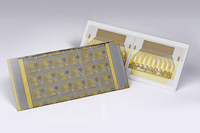The additive process defines circuit lines by adding (electroplating) conductive material on top of a thin metal film that’s been fully-sputtered onto a substrate. The places where metal is added are defined by a stencil of photoresist material that remains on the metal film following photolithography. The subtractive process defines circuit lines by removing (chemical etching) conductive material out of a thick metal film that’s been sputtered onto a substrate.
additive process will likely achieve:
- More uniform circuit lines (i.e., same width top and bottom)
- More consistent trace definition
- More consistent circuit electrical and mechanical performance
- Thinner and therefore more flexible circuits (where needed)
- Higher density circuit resolution (more conductive traces packed into a smaller area)
- More control across a wider range of circuit resolution, flexibility/rigidness, and trace thickness
Considering a miniature circuit for your next design? Ask us for a quote.


